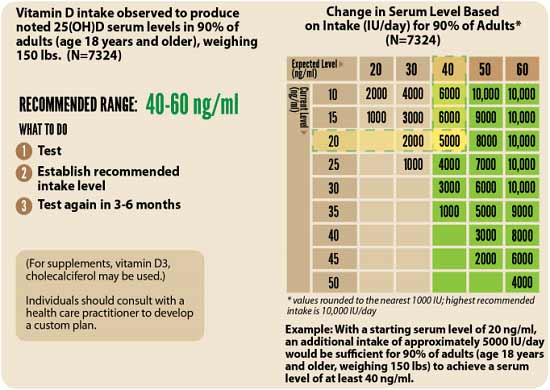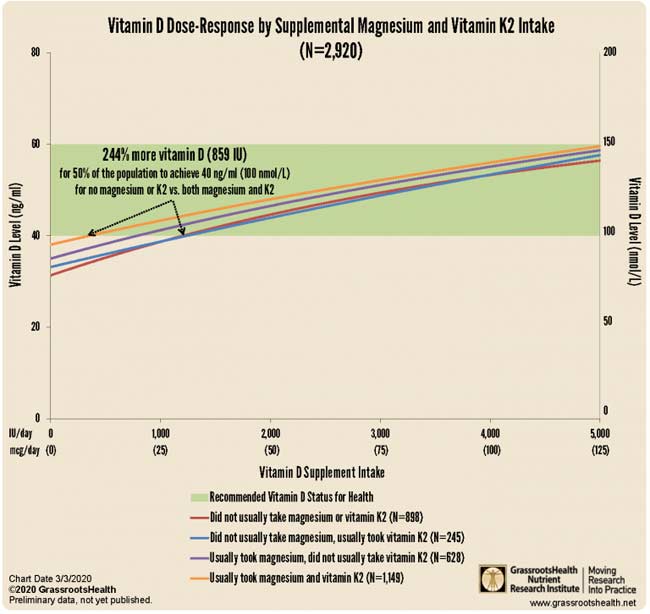Contributing writer for Wake Up World
Vitamin D regulates the expression of hundreds of genes and is integral to biological functions that affect every bodily system. As you’ll see in this short video, vitamin D insufficiency or deficiency can trigger several generalized symptoms that you may have associated with other health conditions.
It is also called the sunshine vitamin since your skin makes vitamin D when exposed to ultraviolet light from the sun.1 Vitamin D performs many functions within the body, including maintaining adequate levels of calcium and phosphate, essential for normal bone mineralization.2
[pro_ad_display_adzone id=”110028″]
It helps reduce inflammation, which is necessary for the modulation of cell growth and immune function. Vitamin D also affects genes that help regulate cell differentiation and apoptosis.
The main indicator of your vitamin D level is 25-hydroxyvitamin D (25OHD). Data collected from the National Health and Nutrition Examination Survey in 2005-2006 showed a deficiency prevalence of 41.6% in the U.S. population.3 However, as I discuss later in this article, as many as 80% of people may be deficient in vitamin D.
It’s important to note that how the measurement of insufficiency and deficiency is defined depends on the serum concentrations used. Some researchers use a level of 20 nanograms per milliliter (ng/mL) or 50 nanomoles per liter (nmol/L); the ng/mL is used most frequently in the U.S. and nmol/L is the standard in Europe.
However, GrassrootsHealth Nutrient Research Institute recommends vitamin D serum concentration levels from 40 ng/mL to 60 ng/mL or 100 nmol/L to 150 nmol/L.4 At this level, the number of people who are likely deficient in vitamin D would be significantly higher.
14 Signs You Might Have a Vitamin D Deficiency
During cold and flu season, and the COVID-19 pandemic, it is essential to maintain healthy levels of vitamin D to help reduce your risk of viral and bacterial illness.5,6 A blood test is the best way to determine your vitamin D levels, but here are some symptoms that may indicate your levels are low.
1.Aching muscles — Nearly half of all adults are affected by muscle pain.7 Researchers believe most of those are deficient in vitamin D. Some studies have suggested that nerves have vitamin D receptors that affect the perception of pain. In one animal model, research demonstrated a vitamin D-deficient diet can induce deep muscle hypersensitivity that was not connected to low levels of calcium.8
2.Painful bones — Vitamin D regulates the level of calcium in your body, necessary to protect bone health.9 Vitamin D deficiency can cause your bones to soften, called osteomalacia. This may be a precursor to osteoporosis.
3.Fatigue — This is a common symptom of a variety of different health conditions, including sleep deprivation. Researchers have found that supplementing cancer patients suffering from fatigue can improve their symptoms.10
In one study11 using 174 adults with fatigue and stable medical conditions, the researchers found 77.2% were deficient in vitamin D. After normalizing their level, the fatigue symptoms improved significantly.
4.Reduced muscle performance — Vitamin D deficiency is as common in athletes as in others. Vitamin D is crucial for muscle development, strength and performance. Older adults taking a vitamin D supplement have a reduced risk of falls and improved muscle performance.12
Correction through oral supplementation or sensible sun exposure may reduce symptoms of stress fractures, musculoskeletal pain and frequent illness. Vitamin D also has a direct effect on muscle performance. In one paper from the Journal of the American Academy of Orthopaedic Surgeons, the author wrote:13
“Higher serum levels of vitamin D are associated with reduced injury rates and improved sports performance. In a subset of the population, vitamin D appears to play a role in muscle strength, injury prevention, and sports performance.”
5.Brain health — Vitamin D is also essential for your brain health. Symptoms of deficiency can include dementia caused by an increase of soluble and insoluble beta-amyloid, a factor in Alzheimer’s disease.14 Research has also found an association with depression15 that may be associated with the function of vitamin D buffering higher levels of calcium in the brain.16
Vitamin D deficiency in pregnant women can increase the risk of autism and schizophrenic-like disorders in the baby.17 One study of people with fibromyalgia found a vitamin D deficiency was more common in those who had anxiety and depression.18 Another looked at vitamin D deficiency in obese subjects and found a relationship between low levels of vitamin D and depression.19
6.Poor sleep — The mechanism linking vitamin D and poor sleep quality has not been identified. But research has found people with low levels of vitamin D have poor quality sleep and a higher risk of sleep disorders.20
7.Sweaty head — Excessive sweating, especially on your head, or a change in your pattern of sweating, can indicate a vitamin D deficiency.21
8.Hair loss — Vitamin D is crucial to the proliferation of keratinocytes and plays an important role in your hair cycle. The vitamin D receptor appears to play a role in the anagen phase of hair growth, leading researchers to conclude, “Treatments that upregulate the vitamin D receptor may be successful in treating hair disorders and are a potential area of further study.”22
9.Slow-healing wounds — Chronic wounds are a major public health challenge.23 In the U.S. 2% of the population is affected by chronic wounds and it is estimated to account for 5.5% of the cost of health care in the U.K. NHS. Vitamin D promotes wound healing and the creation of cathelicidin, a peptide that fights wound infections.24
10.Dizziness — Evidence from animal models suggests that vitamin D is critical in the development of the inner ear,25 which affects balance and coordination. Analysis of people with vestibular neuritis, characterized by vertigo, showed lower serum vitamin D levels than in people without vestibular neuritis.26
11.Heart problems — Clinical studies have shown that vitamin D3 improves circulation and can help improve high blood pressure.27 In one study28 researchers discovered that vitamin D3 also has a significant effect on the endothelial cells that line your cardiovascular system. They found that it helped balance concentrations of nitric oxide and peroxynitrite, which improved endothelial function.
12.Excess weight — How vitamin D affects obesity has not been identified. However, data do show there is a high probability of deficiency in people who are obese.29
13.Recurring infections — There have been multiple epidemiological studies that show vitamin D deficiency can increase the risk of infection and raise the severity, particularly in respiratory tract infections.30 Multiple studies have demonstrated that vitamin D deficiency increases the potential risk for severe disease and mortality, especially in those who are critically ill.31
14.Reduced cognitive function — Data show that vitamin D deficiency increases your risk of dementia twofold32 and raises your risk of impaired cognitive function.33
80% of People With COVID-19 Are Deficient in Vitamin D
Vitamin D plays an important role in the development and severity of many diseases. This is why, from the very beginning of the COVID-19 pandemic, I suspected that optimizing vitamin D levels would significantly lower the incidence of infection and death in the general population.
Since then, mounting evidence has revealed this is indeed the case as researchers have repeatedly found that higher levels of vitamin D reduce the rate of positive tests, hospitalizations and mortality related to this infection.
One study,34 released in late 2020, assessed the serum 25OHD levels of patients hospitalized with COVID-19 to evaluate the influence it might have on the severity of the disease. The researchers found 82.2% of those with COVID-19 were vitamin D deficient (levels lower than 20 ng/mL).
Interestingly, they also found those who were deficient had a greater prevalence of cardiovascular disease, high blood pressure, high iron levels and longer hospital stays. A second study35 found similar results for people who only tested positive for COVID-19.
In other words, these patients were tested for the illness using the PCR test, which gives notoriously high false-positive results, and did not necessarily have symptoms of the illness. Yet, those who were “likely deficient” in vitamin D also had an increased risk of testing positive.
Recently, data showed people who received supplemental vitamin D3 while hospitalized with COVID-19 had reduced admissions to the ICU by 82% and reduced mortality by 64%.36 Editor’s note: This preprint study has since been pulled due to “concerns about the description of the research in this paper,”37 but an archived version is still available.
You can read more about the study, from information published before being pulled, at “Vitamin D Supplementation Reduces COVID-19 Deaths by 64%.”
Before the paper was removed, this information triggered British MP David Davis to call for a reevaluation of the official recommendations for vitamin D. He tweeted, “The findings of this large and well-conducted study should result in this therapy being administered to every COVID patient in every hospital in the temperate latitudes.”38
He added that the demonstration of the “clear relationship between vitamin D and COVID mortality is causal,” and his government should raise the availability of free vitamin D supplements to vulnerable populations. Other experts also called for official vitamin D recommendations.39
It’s important to remember the data showing people who are deficient in vitamin D have a higher risk of severe disease has been available long before the COVID-19 pandemic. Yet, information that may suggest the other side of the same coin — namely supplementing with vitamin D — may have a positive effect on disease severity, can come under attack.
It isn’t a big leap to understand that if simple and inexpensive solutions, such a vitamin D, hydroxychloroquine and zinc, may reduce the potential risk of severe disease and death, the billions of dollars the pharmaceutical companies stand to make by vaccinating the world would be lost.
Unlike the painful reports of vaccine adverse events received by the U.S. Vaccine Adverse Event Reporting System (VAERS), supplementing with vitamin D, magnesium and vitamin K2 have been studied for years and found to be “well tolerated.”40,41
Added to which, the studies on vitamin D have demonstrated insufficiency and deficiency are associated with a number of health conditions, which you can find more information about in “Are You Ready for the Darkest Day of the Year?” and “Health Conditions in Which Vitamin D Plays an Important Role.”
Magnesium and Vitamin K2 Optimize Your Vitamin D3 Supplement
In the past, I’ve written about the importance of taking vitamin K2 MK-7 and magnesium with your vitamin D3 supplement. Both play an important role in your overall health and in the bioavailability and application of vitamin D in your body. If you’re not using magnesium and vitamin K2, you could need nearly 2.5 times more vitamin D, which GrassrootsHealth discovered in its D*action project.42
Over 10,000 individuals provided information about supplement use and overall health status to GrassrootsHealth since they began conducting large-scale population-based nutrient research in 2007.43
That information has led to the recommendation that vitamin D blood levels between 40 ng/ml and 60 ng/ml (100 nmol/L to 150 nmol/L) are safe, effective and lower overall disease incidence and health care costs. As reported by GrassrootsHealth from their data:44
“… 244% more supplemental vitamin D was needed for 50% of the population to achieve 40 ng/ml (100 nmol/L) for those not taking supplemental magnesium or vitamin K2 compared to those who usually took both supplemental magnesium and vitamin K2.”
In practical terms, this means when you take vitamin K2 and magnesium with vitamin D, you need far less vitamin D to achieve a healthy level. You’ll find more about the relationship between these supplements, how they can improve cognitive function and the impact on mortality at “Magnesium and K2 Optimize Your Vitamin D Supplementation.”
How to Optimize Your Vitamin D
While most people would probably benefit from a vitamin D3 supplement, it’s important to get your vitamin D level tested before you start supplementing. The reason for this is because you cannot rely on blanket dosing recommendations. The crucial factor here is your blood level, not the dose, as the dose you need is dependent on several individual factors, including your baseline blood level.
Data from GrassrootsHealth’s D*Action studies suggest the optimal level for health and disease prevention is between 60 ng/mL and 80 ng/mL, while the cutoff for sufficiency appears to be around 40 ng/mL. In Europe, the measurements you’re looking for are 150 to 200 nmol/L and 100 nmol/L respectively.
I’ve published a comprehensive vitamin D report in which I detail vitamin D’s mechanisms of action and how to ensure optimal levels. I recommend downloading and sharing that report with everyone you know. A quick summary of the key steps is as follows:
-
- First, measure your vitamin D level — One of the easiest and most cost-effective ways of measuring your vitamin D level is to participate in the GrassrootsHealth’s personalized nutrition project, which includes a vitamin D testing kit.Once you know what your blood level is, you can assess the dose needed to maintain or improve your level. If you cannot get enough vitamin D from the sun (you can use the DMinder app to see how much vitamin D your body can make depending on your location and other individual factors), then you’ll need an oral supplement.
- Assess your individualized vitamin D dosage — To do that, you can either use the chart below, or use GrassrootsHealth’s Vitamin D*calculator. To convert ng/mL into the European measurement (nmol/L), simply multiply the ng/mL measurement by 2.5. To calculate how much vitamin D you may be getting from regular sun exposure in addition to your supplemental intake, use the DMinder app.

- Retest in three to six months — Lastly, you’ll need to remeasure your vitamin D level in three to six months, to evaluate how your sun exposure and/or supplement dose is working for you.
Take Your Vitamin D With Magnesium and K2
As detailed in “Magnesium and K2 Optimize Your Vitamin D Supplementation,” it’s strongly recommended to take magnesium and K2 concomitant with oral vitamin D. Data from nearly 3,000 individuals reveal you need 244% more oral vitamin D if you’re not also taking magnesium and vitamin K2.
What this means in practical terms is that if you take all three supplements in combination, you need far less oral vitamin D in order to achieve a healthy vitamin D level.

Sources and references:
- 1 National Institutes of Health, Vitamin D
- 2 Oregon State University, Vitamin D
- 3 Cureus, 2018;10(6)
- 4, 42, 44 GrassrootsHealth Magnesium and Vitamin K2 Combined Important for Vitamin D Levels
- 5 Harvard Gazette, February 15, 2017
- 6 DermatoEndocrinology, 2012;4(2)
- 7, 8 Journal of Neuroscience, 2011;31(39)
- 9 U.S. Pharmacist, 2009;34(3)
- 10, 11 North American Journal of Medical Sciences, 2014;6(8)
- 12 Current Opinions in Clinical Nutrition and Metabolic Care, 2009;12(6)
- 13 Journal of the American Academy of Orthopaedic Surgeons, 2018;26(8)
- 14 Cureus, 2018;10(7) Abstract
- 15 Neuropsychiatry, 2017;7(5)
- 16, 17 Cureus, 2018;10(7)
- 18 Clinical Rheumatology, 2007;26:551
- 19 Journal of Internal Medicine, 2008; doi.org/10.111/j.1365-2796.2008.02008.x
- 20 Nutrients, 2018;10(10)
- 21 Science Care, January 10, 2017
- 22 Dermatology Online Journal, 2010;16(2):3
- 23 Advances in Wound Care, 2019;8(2)
- 24 Today’s Wound Clinic, 2016;10(11)
- 25 Biochemical and Biophysical Research Communications, 2016;478(2)
- 26 Frontiers in Neurology, 2019; doi.org/10.3389/fneur.2019.00863
- 27 Science Daily, April 3, 2011
- 28 International Journal of Nanomedicine, 2018;13:455
- 29 Medicina, 2019;55(9)
- 30 Inflammation and Allergy – Drug Targets, 2013;12(4)
- 31 Critical Care, 2014;8(6)
- 32 University of Exeter, August 6, 2014
- 33 JAMA Neurology, 2015;72(11)
- 34 The Journal of Clinical Endocrinology and Metabolism, 2020; doi.org/10.1210/clinem/dgaa733
- 35 JAMA, 2020;3(9):e2019722
- 36 Preprints, The Lancet, January 22, 2021; doi.org/10.2139/ssrn.3771318
- 37 Europe PMC January 21, 2021
- 38 The Sun, February 14, 2021
- 39 Irish Times, February 15, 2021
- 40 Scandinavian Journal of Rheumatology, 2009;38(2):149
- 41 Journal of Nutrition and Metabolism, 2017;2017:6254836
- 43 GrassrootsHealth.net
Originally published at mercola.com and reproduced here with permission.
Recommended articles by Dr. Joseph Mercola:
- Mind to Matter: How Your Brain Creates Material Reality
- Breathwork Helps Tame Stress, Benefits Mind and Body
- More Evidence Supports Benefits of Medicinal Mushrooms
- Practicing Gratitude During the Covid 19 Pandemic
- Here’s What You Should Know About Pumpkins
- Drinking Green Tea, Coffee Linked to Lower Mortality
- The Interconnectedness Between Anxiety and Inflammation
- What Can Olive Leaf Extract Do For You?
- Beets for Better Lung Efficiency
- The Little Known Sordid History of Psychiatry
About the author:
Born and raised in the inner city of Chicago, IL, Dr. Joseph Mercola is an osteopathic physician trained in both traditional and natural medicine. Board-certified in family medicine, Dr. Mercola served as the chairman of the family medicine department at St. Alexius Medical Center for five years, and in 2012 was granted fellowship status by the American College of Nutrition (ACN).
While in practice in the late 80s, Dr. Mercola realized the drugs he was prescribing to chronically ill patients were not working. By the early 90s, he began exploring the world of natural medicine, and soon changed the way he practiced medicine.
In 1997 Dr. Mercola founded Mercola.com, which is now routinely among the top 10 health sites on the internet. His passion is to transform the traditional medical paradigm in the United States. “The existing medical establishment is responsible for killing and permanently injuring millions of Americans… You want practical health solutions without the hype, and that’s what I offer.”
Visit Mercola.com for more information, or read Dr. Mercola’s full bio and resumé here.
[pro_ad_display_adzone id=”110027″]








